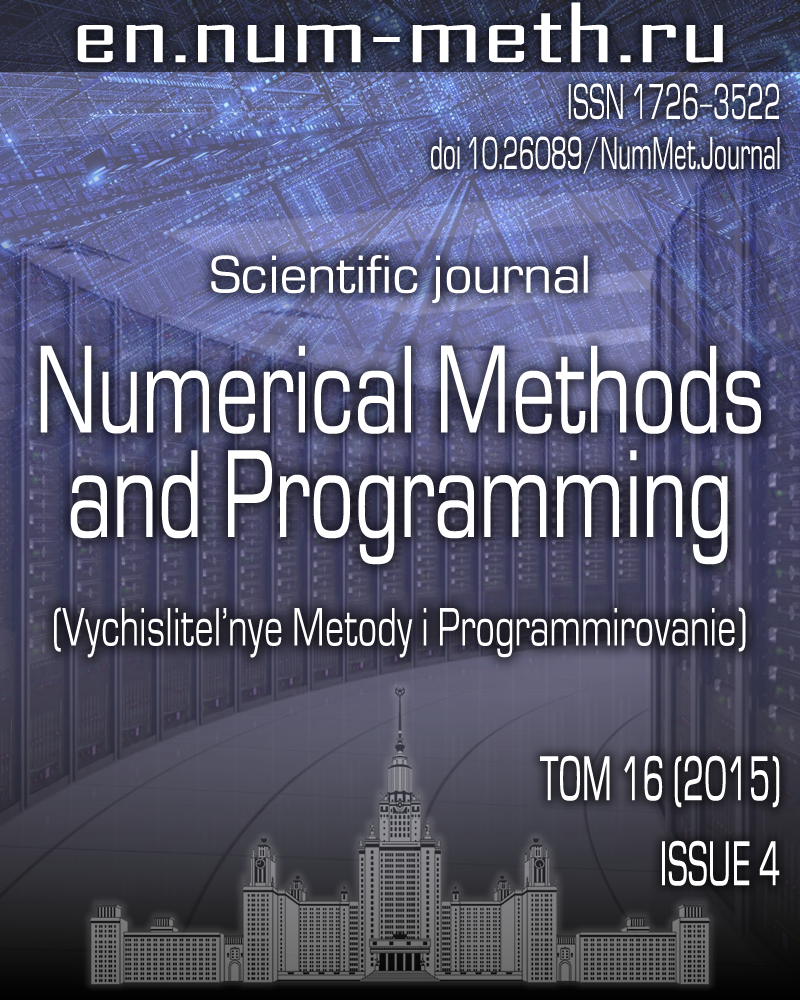DOI: https://doi.org/10.26089/NumMet.v16r447
An iterative method for determining the shape and conductivity of a homogeneous inclusion in the two-dimensional electrical impedance tomography problem
Keywords:
electrical impedance tomography
piecewise constant conductivity
iterative method
Tikhonov regularization method
Abstract
The problem of electrical impedance tomography in a bounded two-dimensional domain with a piecewise two-valued constant electrical conductivity is considered. It is required to determine an unknown boundary between the regions of different conductivities and to obtain the conductivity in one of these regions using the input information on the electric field measured on the outer boundary of the domain. An iterative method for solving this problem is proposed. The corresponding numerical results are discussed.
Published
2015-09-06
Issue
Section
Section 1. Numerical methods and applications
References
- L. Borcea, “Electrical Impedance Tomography,” Inverse Probl. 18 (6), 99-136 (2002).
- G. J. Saulnier, R. S. Blue, J. C. Newell, et al., “Electrical Impedance Tomography,” IEEE Sig. Proc. Mag. 18 (6), 31-43 (2001).
- M. Hanke and M. Brühl, “Recent Progress in Electrical Impedance Tomography,” Inverse Probl. 19 (6), S65-S90 (2003).
- G. Alessandrini and V. Isakov, “Analyticity and Uniqueness for the Inverse Conductivity Problem,” Rend. Ist. Mat. Univ. Trieste 28, 351-369 (1996).
- B. Barceló, E. Fabes, and J. K. Seo, “The Inverse Conductivity Problem with one Measurement: Uniqueness for Convex Polyhedra,” Proc. Amer. Math. Soc. 122 (1), 183-189 (1994).
- H. Bellout, A. Friedman, and V. Isakov, “Stability for an Inverse Problem in Potential Theory,” Trans. Amer. Math. Soc. 332 (1), 271-296 (1992).
- K. Astala and L. P854iv854rinta, “Calderón’s Inverse Conductivity Problem in the Plane,” Ann. Math. 163, 265-299 (2006).
- H. Kang, J. K. Seo, and D. Sheen, “Numerical Identification of Discontinuous Conductivity Coefficients,” Inverse Probl. 13 (1), 113-123 (1997).
- M. Brühl and M. Hanke, “Numerical Implementation of Two Noniterative Methods for Locating Inclusions by Impedance Tomography,” Inverse Probl. 16 (4), 1029-1042 (2000).
- H. Eckel and R. Kress, “Nonlinear Integral Equations for the Inverse Electrical Impedance Problem,” Inverse Probl. 23 (2), 475-491 (2007).
- K. Knudsen, M. Lassas, J. L. Mueller, and S. Siltanen, “Regularized D-Bar Method for the Inverse Conductivity Problem,” Inverse Probl. Imaging 3 (4), 599-624 (2009).
- M.-E. Ts, E. Lee, J. K. Seo, et al., “Projective Electrical Impedance Reconstruction with Two Measurements,” SIAM J. Appl. Math. 73 (4), 1659-1675 (2013).
- A. M. Denisov, E. V. Zakharov, A. V. Kalinin, and V. V. Kalinin, “Numerical Methods for Some Inverse Problems of Heart Electrophysiology,” Differ. Uravn. 45 (7), 1014-1022 (2009) [Differ. Equ. 45 (7), 1034-1043 (2009)].
- S. V. Gavrilov, “Numerical Conditioning Analysis of Two-Dimensional Problems in Electrical Impedance Tomography,” Vychisl. Metody Programm. 15, 329-336 (2014).
- S. V. Gavrilov and A. M. Denisov, “Numerical Methods for Determining the Inhomogeneity Boundary in a Boundary Value Problem for Laplace’s Equation in a Piecewise Homogeneous Medium,” Zh. Vychisl. Mat. Mat. Fiz. 51 (8), 1476-1489 (2011) [Comput. Math. Math. Phys. 51 (8), 1377-1390 (2011)].

